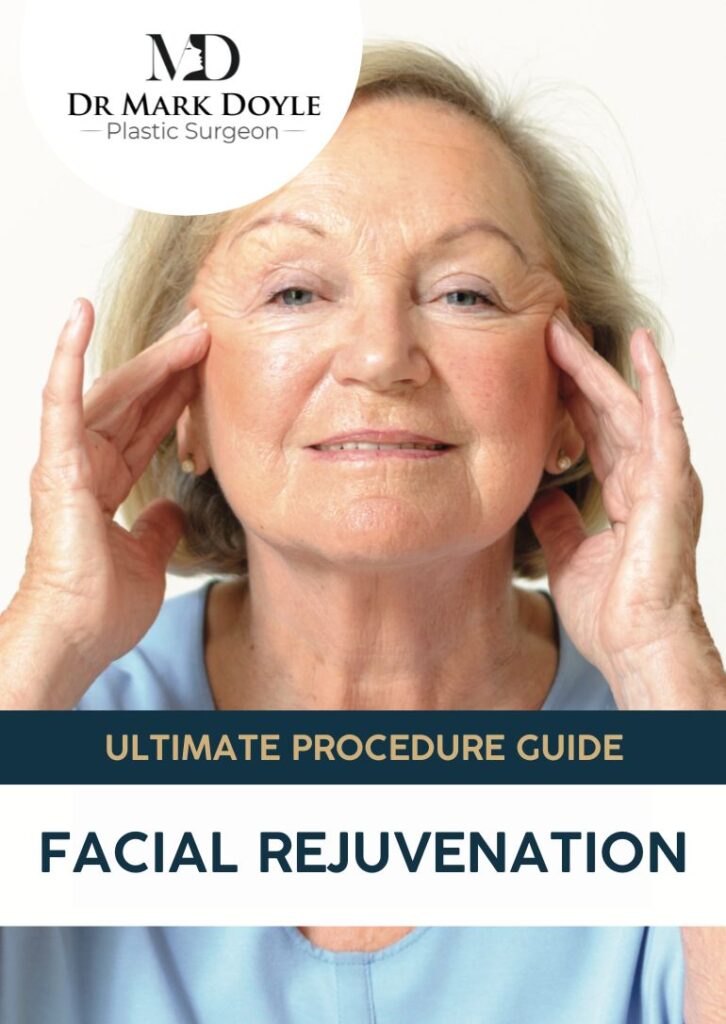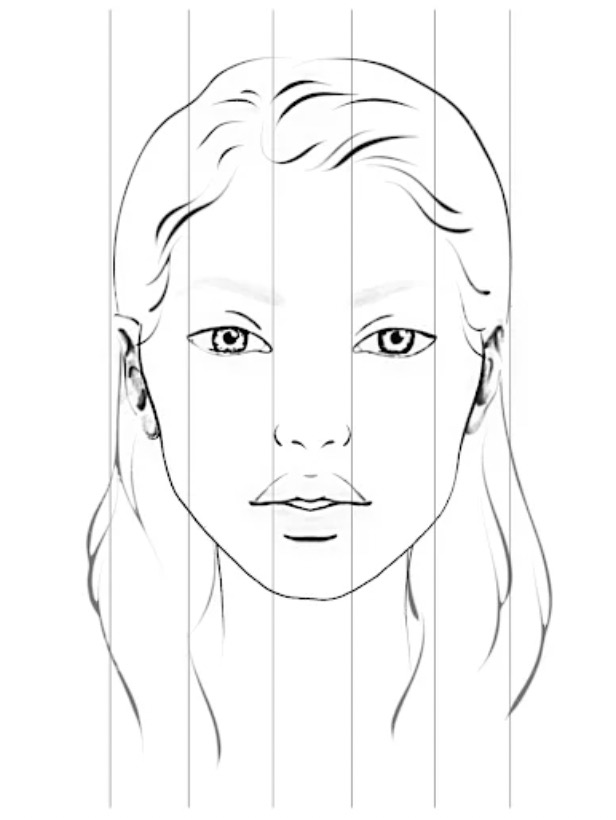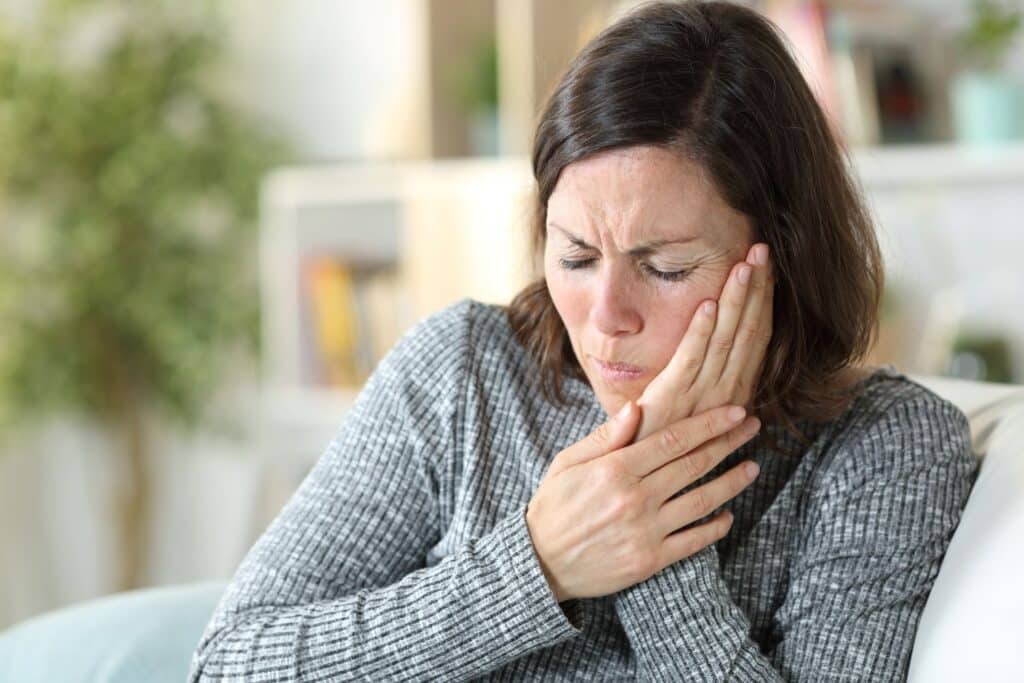Facial symmetry refers to the degree to which the left and right sides of the face are similar in terms of size, shape, and position of facial features. An asymmetrical face, on the other hand, is when the two sides of the face are noticeably different from each other. Common causes of an asymmetrical face are genetics, injury and ageing.
Studies have shown that people tend to find symmetrical faces more attractive than those that are not. However, it’s important to remember that everyone’s face is unique, and minor asymmetry is completely normal and often not noticeable to others.
Guide to Facial Rejuvenation

Facial Rejuvenation
What Causes Asymmetrical Face

Asymmetrical faces can be caused by a wide range of factors, both internal and external, which affect the growth, development, and function of the face.
While minor facial asymmetry is completely normal and often goes unnoticed, more significant asymmetry can be a source of insecurity and self-consciousness for some people. There are many potential factors that can contribute to an asymmetrical face listed below.
Genetics
One of the most common causes of an asymmetrical face is genetics. Some people are simply born with facial asymmetry due to differences in the way their facial bones and muscles develop. For example, differences in the size and shape of the facial bones or the position of the jaw can lead to an uneven face.
There are also a number of genetic conditions that can lead to an asymmetrical face. These conditions are often caused by mutations or abnormalities in the genes that control facial development. Examples include:
- Hemifacial microsomia: This is a condition in which one side of the face is underdeveloped, leading to noticeable asymmetry.
- Goldenhar syndrome: This is a rare genetic disorder that affects the development of the face, particularly the eyes, ears, and jaw.
- Craniosynostosis: This is a condition in which the bones of the skull fuse too early, leading to abnormal growth and development of the head and face.
Injury or Trauma
Injury is another common cause of an asymmetrical face. Trauma to the face, such as a broken nose or cheekbone, can cause asymmetry by changing the shape and position of the facial bones. This can happen as a result of falls, sports injuries, and motor vehicle accidents. Types of injuries that can affect facial symmetry include fractures, soft tissue injuries, burns and nerve damage.
It’s important to seek medical attention for facial trauma, even if the injury seems minor. A qualified medical professional can assess the extent of the injury and provide appropriate treatment to minimise the risk of complications and promote healing.
Dental Problems
Dental issues can also cause facial asymmetry and an asymmetrical jaw. Problems with teeth alignment or jaw position can lead to noticeable differences between the two sides of the face. For example, if the jaw is misaligned, one side of the face may appear more prominent or more recessed than the other.
One of the most common dental issues that can affect facial symmetry is the misalignment of the teeth. This can cause the teeth on one side of the mouth to protrude further than the teeth on the other side, leading to noticeable asymmetry. This also affects the position of the jaw, which can further contribute to jaw asymmetry.
Lifestyle Factors
Lifestyle factors can also contribute to an asymmetrical face over time. For example, poor diet, sleep position, posture, lack of exercise, sun exposure and smoking can all affect the face.
This includes the development and function of the face, and the appearance of the skin and muscles in the face, which leads to asymmetry and other signs of ageing. It’s important to make lifestyle changes in order to improve facial symmetry and overall health.
Ageing
Ageing can cause facial asymmetry through a variety of mechanisms. Here are a few examples:
- Changes in bone structure: As we age, our bones gradually lose density and volume.
- Muscle tone changes: Ageing can also cause changes in muscle tone, as these muscles weaken, they may not be able to support the skin and soft tissue as effectively as they once did, leading to sagging or drooping on one side of the face.
- Skin elasticity changes: As we age, our skin loses elasticity and becomes less able to bounce back from stretching or sagging. This can contribute to facial asymmetry by causing one side of the face to appear more wrinkled or droopy than the other.
To prevent or minimise age-related facial asymmetry, there are several things you can do:
- Stay hydrated
- Protect your skin from the sun
- Exercise regularly
- Practice good skincare
Types of Asymmetrical Face
Facial asymmetry is a condition where one side of a person’s face is different in size, shape, or position compared to the other side. There are two primary types of facial asymmetry: developmental and acquired.
Developmental facial asymmetry may be caused by genetic factors or environmental factors. Acquired facial asymmetry, is a result of an injury or medical condition. Understanding the different types of facial asymmetry is important for accurate diagnosis and effective treatment.
Developmental Asymmetry

Developmental facial asymmetry refers to differences in facial structure that occur during embryonic development, childhood, or adolescence. It may be caused by genetic factors, environmental factors, or a combination of both. Some common examples of developmental facial asymmetry include:
- Misaligned nose
- Uneven eyes or eyebrows
- Crooked smile or an asymmetrical jaw
Acquired Asymmetry

Acquired facial asymmetry, refers to differences in facial structure that occur later in life. Asymmetrical face causes are usually a result of external factors such as an injury or medical condition. This type of facial asymmetry can occur suddenly or gradually and can affect any part of the face. For example, an injury to the face or head can cause swelling or scarring, which can lead to asymmetry. Other conditions that can cause acquired facial asymmetry include:
- Stroke
- Facial paralysis
- Dental problems or TMJ disorder
- Sleeping on one side of the face
Non-surgical Treatments for Asymmetrical Face

If you have facial asymmetry, there are non-surgical treatment options available to help improve a crooked face without undergoing invasive procedures. Here are some non-surgical treatments for an asymmetrical face:
- Dermal filler: Help restore depleted volume and natural curves of the face. This can help to add volume in the face where it may be asymmetrical.
- Anti wrinkle injections: These injections can relax the muscles which cause facial wrinkles which can cause asymmetry in the face. By dimishing the appearance of the wrinkles the face can appear more symmetrical.
- Dental treatments to fix asymmetrical bite: An asymmetrical bite can cause an asymmetrical face. Dentists can help correct the bite through orthodontic treatments such as braces or Invisalign. These treatments can help align the teeth and jaw, which can improve facial symmetry.
- Facial exercises for asymmetrical face: Facial exercises can help strengthen the muscles on one side of the face, which can help balance out the facial features. For example, doing exercises like puckering your lips, raising your eyebrows, and smiling can help improve the symmetry of the face.
- Massage therapy to improve blood flow and relax facial muscles: Massaging the face can improve blood flow, which can help reduce puffiness and swelling. It can also help relax the facial muscles, which can help reduce tension and improve facial symmetry.
- Makeup tips to create the illusion of symmetry: Makeup can be a powerful tool to create the illusion of symmetry. Using makeup techniques such as contouring and highlighting can help balance out an asymmetrical face and create a more symmetrical appearance.
- Hairstyles that can balance an asymmetrical face: Certain hairstyles can help balance out an asymmetrical face. For example, a side-swept fringe can help cover up a larger forehead, while layers can help create volume and movement to balance out an asymmetrical jawline.
Surgical Treatments for Asymmetrical Face

Asymmetrical face surgery may be an option to correct the underlying issues. Here are some common facial asymmetry surgery treatment options.
- Facial fat transfer to correct asymmetry: Fat transfer can be used to improve uneven face cheeks. Fat taken from your body is inserted into the soft tissue to improve facial balance and symmetry.
- Rhinoplasty to balance the nose: Rhinoplasty, also known as a nose job, can be used to improve an asymmetrical nose. It does this by changing the shape and size of the nose to balance out an asymmetrical face.
- Facelift to improve overall facial balance: A facelift can be used to address the signs of ageing and improve overall facial balance by tightening and lifting the skin on the face and neck.
- Blepharoplasty to correct asymmetry in the eyelids: Blepharoplasty, or eyelid surgery, can be used to address asymmetry in the eyelids and improve overall facial symmetry.
- Neck lift to address asymmetry in the neck and jawline: A neck lift can be used to improve the appearance of an asymmetrical neck and jawline. It does this by removing excess skin and tightening the muscles in the area.
- Otoplasty to correct asymmetry in the ears: Otoplasty, or ear surgery, can be used to correct asymmetry in the ears. This is best for when one ear is positioned differently or is protruding more than the other.
- Forehead lift: can be used to correct eyebrow asymmetry and tighten loose forehead skin.
It is important to consult with a qualified plastic surgeon to discuss your options and determine the best course of action to achieve facial asymmetry. While surgical treatments can be effective in correcting an asymmetrical face, it is important to have realistic expectations and understand that results may vary.
Maintaining Facial Symmetry
There are ways to promote and maintain facial symmetry through lifestyle changes and self-care practices, however, this won’t guarantee a perfectly symmetrical face.
Regular facial massages and exercises – can help to stimulate blood flow to the face and promote muscle tone. This can help to maintain a more balanced appearance. Some examples of facial exercises include puckering the lips and holding for a few seconds, stretching the mouth wide and holding, and raising the eyebrows while holding for several seconds.
Maintaining a balanced diet and staying hydrated – contribute to facial symmetry. Eating a diet rich in fruits, vegetables, lean protein, and healthy fats can help to nourish the skin and promote overall health. Drinking plenty of water can also help to keep the skin hydrated. This prevents the appearance of fine lines and wrinkles.
Protecting the skin from sun damage – Exposure to UV rays can cause uneven pigmentation, fine lines, and wrinkles. These can all contribute to a less symmetrical appearance. Wearing sunscreen with an SPF of at least 30 and wearing protective clothing, such as hats and sunglasses, can help to prevent sun damage and promote a more balanced complexion.
FAQs
How long does it take to see results from surgical treatment for facial asymmetry?
The recovery time and timeline for seeing results from surgical treatment for asymmetrical face depends on the type and extent of the procedure. In general, it can take several weeks to several months to see the final results. Below are the average recovery times for some of the most popular facial procedures.
- Facelift results can take 2 to 4 weeks.
- Rhinoplasty results can take 2 to 4 weeks.
- Otoplasty results can take 4 to 6 weeks.
- Neck Lift results can take 2 to 6 weeks.
- Blepharoplasty results can take 7 to 14 days.
- Facial fat transfer results can take 2 to 6 weeks.
Can face lift fix asymmetrical face?
A facelift or neck lift can dramatically improve facial balance, by lifting the sides of your face to a more symmetrical level.
Next Step
If you are considering facial asymmetry surgery to correct asymmetry, it is important to consult with a qualified plastic surgeon who can evaluate your specific case and determine the best course of action. Dr Doyle will discuss your goals and expectations in detail, as well as the potential risks and recovery timeline associated with the procedure. You can book your initial consultation below.
About Dr Mark Doyle FRACS (Plast) – Specialist Plastic Surgeon
Dr Mark Doyle is a Specialist Plastic Surgeon with over thirty years of experience. He specialises in face lift surgery in Gold Coast and Brisbane, and also offers a range of body and breast procedures.
Dr Doyle is a fully qualified Doctor and surgeon. He has completed all required training to be a Specialist Plastic Surgeon and is driven by an committed to providing excellent standards of care.
NEXT STEPS
Do Your Research
- Read the Website and Blogs relevant to your procedure
- Read our Frequently Asked Questions
- Learn about the Risks and Complications of Surgery
- Download our Plastic Surgery Guides
- Browse Dr Doyle’s YouTube Channel
What to Bring to Your Plastic Surgeon Consultation
- Bring a friend or relative for support and discussion regarding your choices
- Take notes and read all provided information thoroughly
- Read about what to expect in your Initial Surgery Consultation
Book Your Plastic Surgery Consultation
- Get a Referral from your GP or specialist – this is required to book a consultation with Dr. Doyle.
- Email us or call on 07 5598 0988 to arrange your consultation appointment.
- Pay your $285 Consultation Fee in advance to secure your consultation.
Please contact us to arrange to book a consultation with our Specialist Plastic Surgeon or to speak with our Patient Care Advisor.
Send an enquiry form today or phone 07 5598 0988 during Clinic Hours.
–
*DISCLAIMER: All information on Dr Mark Doyle website is general and is not intended to be medical advice nor does it constitute a doctor-patient relationship. Results can vary significantly and depend on individual patient circumstances. All images on this website, unless specified as real patient images, are stock images used for illustrative purposes only. Surgery risks and complications will be covered in detail during a consultation with your surgeon. Book a consult for details regarding your cosmetic surgery procedure.
Dr. Mark Doyle AHPRA Registration: Dr Mark Doyle MED0001375519 Specialist Plastic Surgery – MBBS FRACS FRCS




